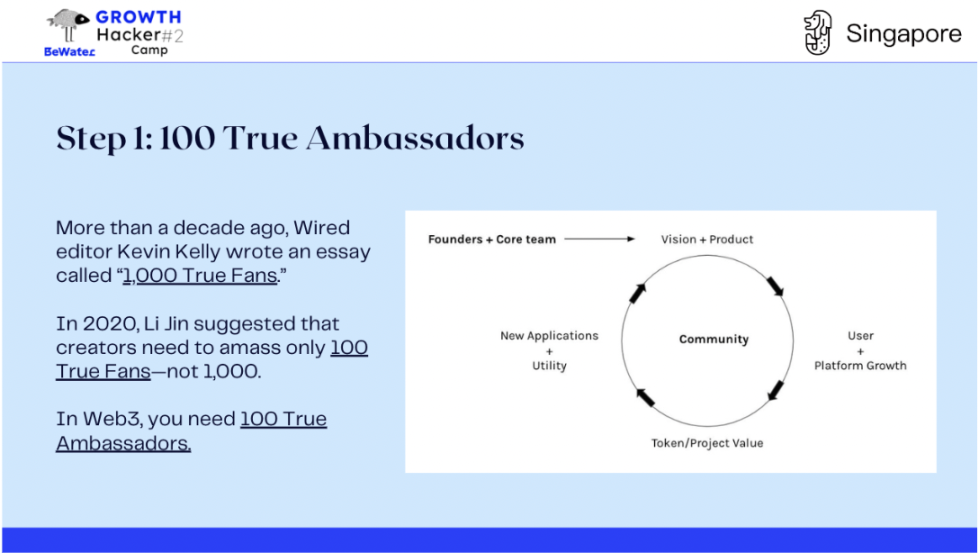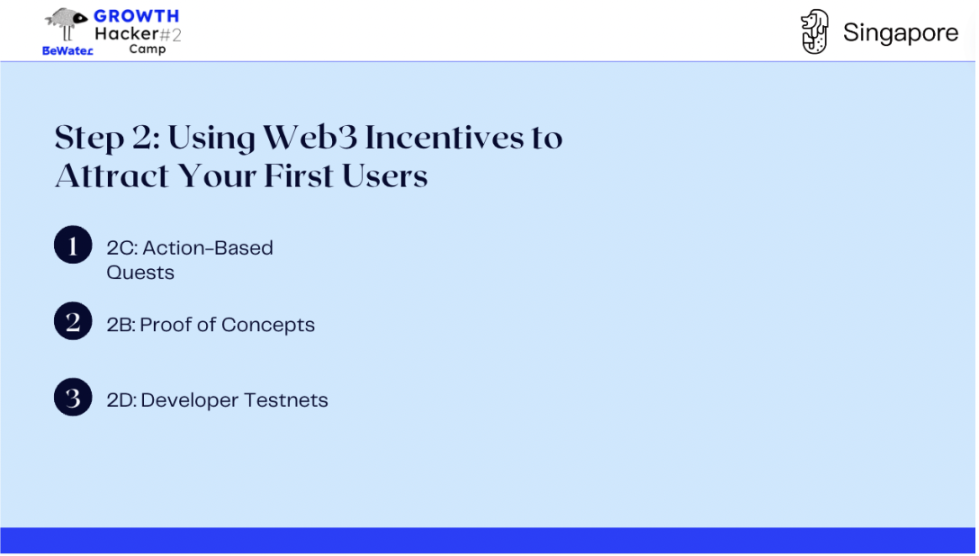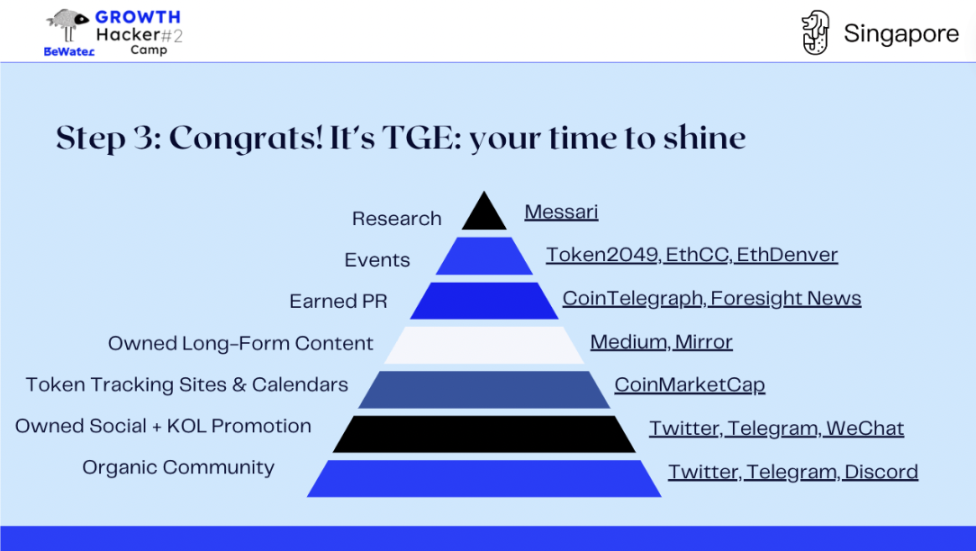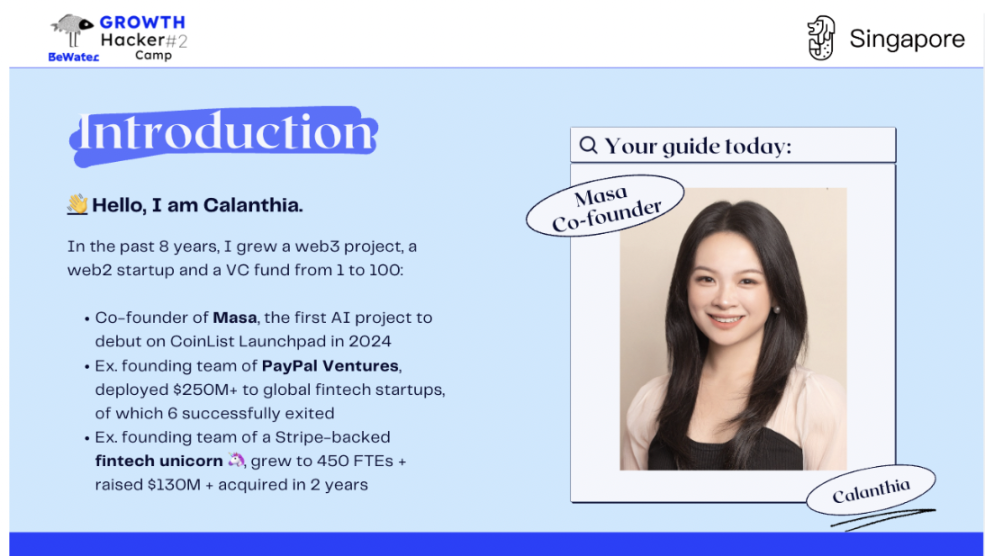As a preliminary stage for the Web3 community, you need 100 real ambassadors.
Mentor: Calanthia Mei, Masa Co-Founder
Editor & Organizer: BeWater
Preface: On September 21, the second Growth Hacker Camp jointly hosted by BeWater & PANews concluded successfully in Singapore. In this event, mentors from top Web3 projects and VCs delved into core topics such as personal branding, growth strategies, community building, user retention, and conversion, providing valuable insights and inspiration to the attendees.
The growth training camp was well received, and BeWater has compiled the content shared by the mentors into articles and created a "Growth" series for readers! The second article in this series is "Web3 Viral Marketing Manual: Growth Hacker Strategies Applicable to Every Project Stage" by Calanthia Mei, co-founder of Masa. Below is a summary of Calanthia's speech content:
I. Web3 Community Needs 100 Real Ambassadors
Variant Fund co-founder Li Jin said, "Creators only need to accumulate 100 real fans to spread the word about something through word of mouth." Today, I propose a concept, which is that in the preliminary stage of building a Web3 community, you need 100 real ambassadors.
Ambassadors are part of the marketing team. In order to save resources, we generally do not offer full-time opportunities to many partners. Masa has been in operation for over two years, but the entire marketing department consists of no more than three colleagues, including Marketing and Community. So how do we build an Ambassador Program? We initially participated in several incubators, including CoinList Incubator and Binance MVB Incubator. Each incubator Demo Day would attract attention, and many partners would ask how to join Masa. Because our resources are limited, not everyone can become a full-time employee, but you can become an ambassador for our project and start deep cooperation with us.
We recruit a new batch of ambassadors every quarter, with a few thousand people applying each time, and we admit around 500 people. After a few months, the monthly active ambassadors stabilize at around 100-200 people, coming from 40 different countries and regions. We assign tasks to ambassadors every week, such as testing a new product, providing product feedback, or promoting our activities during Token2049. After assigning detailed tasks to them, we can track the completion of the tasks and categorize them at the end of the month based on task completion.
Masa has three types of ambassador reward mechanisms, and based on task completion each month, ambassadors can receive Souldier, Super Soul, and Shining Soul rewards, which can be token incentives. We do this every quarter and every year, which forms a flywheel of 100 real ambassadors. Of course, the initial group of people attracted may not always stay with you, but I think this kind of cultural system can attract a loyal fan base. There is a saying in English called "skin in the game," and tokens can strengthen the connection between ambassadors and projects, making ambassadors hodlers of tokens and using token incentives to help promote your project.

II. Using Web3 Incentives to Attract the First Batch of Users: 2C, 2B, 2D
How to attract the first batch of users? In the product category, the user group has three different profiles, divided into 2C, 2B, and 2D.
First, how to attract the first loyal and enthusiastic C-end users in the currency circle. The task platform is a very good way, but there are two types of tasks, one is relatively simple, and the other is more precise and effective, called Action-Based Quest. For example, if your product is a C-end DApp, then your tasks should not only be to have everyone follow Twitter, join Discord, and TG, but to incentivize their behavior based on their transaction volume or daily activity on your DApp. So don't waste money on those tasks, and instead, put tasks more accurately to attract the first loyal and effective C-end users.
Second is 2B. There are fewer 2B projects in the currency circle because it is difficult and requires long-term serious product development and relationship maintenance. For example, we recently acquired a top twenty Web2 client in North America. I have been persistently building a relationship since the Web3 Carnival in Hong Kong in March, and it took until now to do a POC. It's the same principle as in the traditional Web2 tech circle, which is enterprise sales. It takes a long time to see people's true intentions, and you have to maintain relationships and prove the attractiveness of the product. So the best way is Proof of Concepts. In the currency circle, many people tokenize their products, and many people announce partnerships during Proof of Concepts, and then the token price rises because of "Buy on the Announcement, Sell on the Actual Launch." When the Proof of Concepts truly becomes a product, many people start selling tokens, so you need to understand the delicate relationship between announcements and token price fluctuations.
Third, if you are developing a product for developers, then creating a developer test network is a good method. We have done several Incentivized Testnets with CoinList, which is basically rewarding developers with tokens to do various things. Each time, we can specify that this test network uses $1 million MASA, or this test network gives each participant 100 tokens, and so on. Depending on the different purposes of the test network, different rules can be established.
Based on my experience with 4 or 5 test networks in the past, it is best to shorten the test network period now. The test network period should not be 6 months or 1 year because after the first month, everyone forgets what the test network is for. The test network should be small and beautiful, lasting 3-4 weeks is more appropriate, and then based on everyone's feedback, create the next test network that is better, more beautiful, and more in line with product needs.

III. When the TGE is approaching, how should J people plan their listing?
First and foremost, the community is the most important. The community can be understood as product users, social media followers, or token holders. It is crucial to manage the community well for the listing, as major exchanges evaluate projects based on the number and activity of users in Twitter, Discord, and TG communities, so these three must be managed well. If you want to have an advanced version of the community, you can suggest opening some foreign language communities. Discord can have Sub Channels, and now Telegram can too.
The second point is Owned Social and KOL Promotion, which involves posting articles on various platforms such as the project's official Twitter, Telegram, and WeChat. Each time an article is posted, it must be retweeted within the first hour because it is related to the timeliness of the Twitter algorithm. You need to understand Twitter's algorithm to ensure that more people see your content. KOL Promotion is crucial, as you can ask them to retweet and comment, or share the content in their own communities. The most important aspect of an article's effectiveness is the number of retweets.
The third point is Token Tracking websites like CoinMarketCap or CoinGecko, which have daily rankings showing which tokens are performing the best, with various categories. However, CoinMarketCap receives many applications daily, and the fees are increasing, so if you want to be listed on CoinMarketCap before listing, you must negotiate 2-3 months in advance and be prepared to pay the fee.
The fourth point is Owned Long-Form Content, which refers to self-written articles. Medium and Mirror are commonly used platforms in the English-speaking area for publishing articles. Partnerships, product launches, and testnet launches can all be the subject of a long article. Long-form content can now be completely AI-generated, by feeding all previously published articles (including social media content) to GPT and training it to write in a specific style, reducing the AI's influence.
The fifth point is PR, which is the biggest difference between the Chinese-speaking and English-speaking areas. If you want to be covered by Cointelegraph in the English-speaking area, paying for coverage is not effective. You need to build long-term relationships with journalist friends, keep them updated on your project's progress, and cultivate their genuine interest in your project. This will enable them to report on your project when there are major announcements or listings. Especially since many English-speaking journalists have been laid off this year, so they have fewer resources, and it is essential to build long-term relationships with them. They will only pay attention to you when you have something significant to announce.
The sixth point is events. Events must be held, and there are some tips. First, before attending an event, you need to clarify why you are attending. For example, last year, I came to Singapore to raise funds because we were still in the stage of needing funding before listing. This time, our purpose in coming to Singapore is twofold: to find more product users and to attend events such as the Near User-Owned AI Conference and Bittensor Community Meetup, where there are many developers. We usually demonstrate the product, discuss technical matters, and leave our contact information for them to start using our product, which leads to very clear conversions. Another more subtle form of conversion is exposure. Sometimes I find that while I'm speaking, I can see people in the audience buying our project's tokens, so my goal is to speak in more communities, making the impression of the Masa project concrete, so that every time they think of Masa, they remember the enjoyable hour we spent together. Therefore, events must be purposeful and have a return on investment (ROI), rather than aimlessly attending.
Furthermore, both before and after the event, good publicity must be done. Before the event, we create a poster listing all the events Masa participated in this year, with links to each event's page and registration link. After the event, it is best to write a summary article or create a long thread with photos from each event. Events must have a good start and a good ending to increase the conversion rate.
Lastly, at the top of the pyramid is Research. With many projects preparing for the next bull market, there are many projects out there. In this situation, it is important to connect with reliable and authoritative research institutions using real data and product information to report on our project. In this field, the English research institution Messari is the top choice, followed by Blockworks Research. Messari's fees are very high, and they will send a small team of data analysts to deeply understand your product, including precise product and token data such as holders, circulation, validators, and users. There are several ways to collaborate, such as a one-time research report, which can be done when the market is good, or writing quarterly reports to track progress. If you have the financial strength, after listing the token, it is essential to collaborate with professional and authoritative research institutions to establish the project's credibility.

Question: Every project recruits ambassadors, but your scale is relatively large. What challenges do you encounter in managing ambassadors?
Answer: First, you need to adjust your expectations because ambassadors are initially enthusiastic, but after three months, they become inactive. So, you need to estimate the retention rate, which is approximately 20% to 40%, with about 60% to 80% of people becoming inactive after a quarter. However, it's okay because you can recruit new ambassadors every quarter. Since token incentives are based on their task completion, it is not a waste of money because you are not paying them a monthly or annual salary.
Second, managing ambassadors is very cumbersome and manual. So far, we have not found a suitable platform to automate and streamline the process. Currently, a colleague in the marketing department assigns tasks to ambassadors every week. Every month, the task completion is calculated, and tokens are distributed to them. It is a very complex process, so I recommend having a dedicated community manager to handle this. My main insight is that you always need new blood to keep the ambassador program active.
Question: I have two questions. First, are there any specific characteristics in the distribution of your ambassadors in different regions? Second, before listing, if you don't use U to incentivize, what is the motivation or expectation of the ambassadors?
Answer: We often conduct regional statistics and find that our ambassadors come from 40 different countries, indicating clustering and regional distribution. We found that there are many professional ambassadors from Nigeria, with many people joining our ambassador program. When we last recruited ambassadors, there were over 5,000 applications, and 2,000-3,000 of them were from Nigeria. They are very active, and I really appreciate how they have professionalized the ambassador role. In the Asia-Pacific region, we have many ambassadors in Vietnam, where the enthusiasm for trading coins is particularly high. There is an active community in South Korea, and we have only recently started to focus on the Chinese-speaking region, hoping to do better and make Masa more known to Chinese-speaking partners. On that note, we are currently recruiting the first employee in the Asia-Pacific region, responsible for community and growth.
We also have many ambassadors in the Russian-speaking region because we have a deep history with the CoinList platform. Previously, we did the CoinList Incubator, CoinList Launchpad, and now we are promoting the testnet with CoinList. The top three communities on CoinList are Russia, Ukraine, and Turkey, so we inherited some of their communities, and many of their community members have also joined our community.
The second point is about how to incentivize ambassadors without using U before the token listing. It's like convincing people to buy your tokens; you need to speak with strength and project progress because it is difficult to measure the labor value of ambassadors using U. For example, $5 in Singapore or New York is the price of a cup of coffee, but in a different market, it could be the price of a meal. If you link the labor value to tokens, they will feel incentivized to grow your token, bringing ambassadors closer to the project. So, I prefer the token incentive system for ambassadors.
免责声明:本文章仅代表作者个人观点,不代表本平台的立场和观点。本文章仅供信息分享,不构成对任何人的任何投资建议。用户与作者之间的任何争议,与本平台无关。如网页中刊载的文章或图片涉及侵权,请提供相关的权利证明和身份证明发送邮件到support@aicoin.com,本平台相关工作人员将会进行核查。





